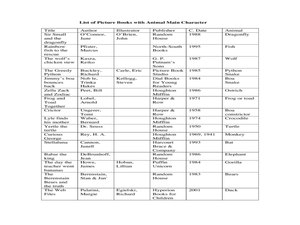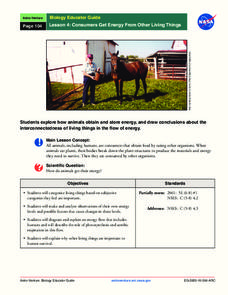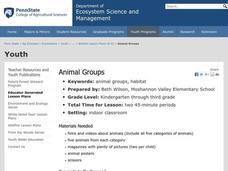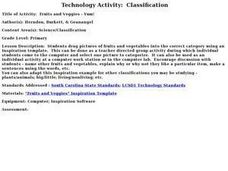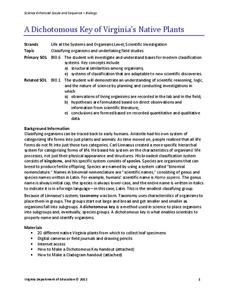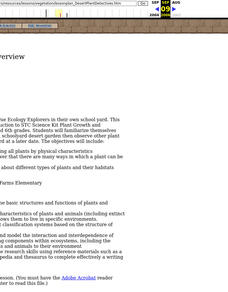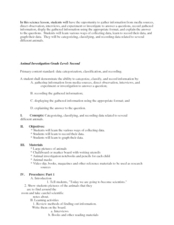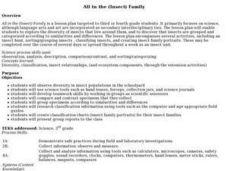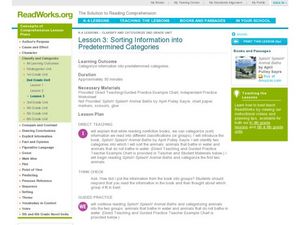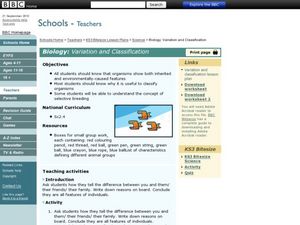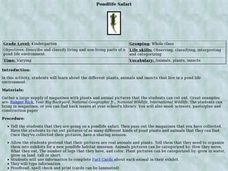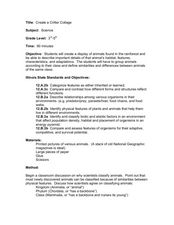Curated OER
Classification of Animals
First graders investigate the characteristics of vertebrates. They classify each as mammal, fish, bird, and reptiles. Students explore the differences between various types of animals and classify each.
Curated OER
Classification of Intertidal Organisma
Students categorize animals. In this animal classification lesson, students group animals by their characteristics. Students break into groups and work together to classify the animals. Students fill out a graphic organizer with their...
Curated OER
Find an Animal! Find a Book!
Learners identify the themes of different books by classifying their genre. In this genre lesson, students examine a specific animal by reading both a nonfiction and fiction book about the species. Learners compare the...
Curated OER
Adding to Sorted Groups
First graders sort pictures of animals into categories. In this sorting lesson plan, learners use the book On The Farm to categorize their animals.
Curated OER
Answering a Research Question
Students explore beginning research skills. In this nonfiction comprehension and research lesson, students generate possible research questions to answer when given the book title of Animals of the Sea and Shore by Ann O. Squire....
NASA
Consumers Get Energy From Other Living Things
How do plants and animals get their food? Learn about where energy comes from, how animals store energy, and aerobic respiration, in a lesson that allows scholars to diagram energy flows.
Curated OER
Classifying Vertebrates
Second graders study animal characteristics and classification. In this animal characteristics and classifications lesson, 2nd graders determine how to classify vertebrates which include mammals, reptiles, amphibians, birds, and fish....
Curated OER
Woodland Animals and Their Habitat
Students explore the natural environment through a video and nature sounds tape. They keep journal's of the unit's activities and vocabulary terms. They play a web of interdependence game and compose a list of forest animals and write...
Curated OER
Animal Groups
Learners explore animal groups. In this animal science lesson plan, students use pictures from magazines and classify the animals into five categories. Learners share why they categorized the animals the way they did.
Curated OER
Critters in Your Own Backyard
Students identify various animals and their habitats, as well as their specific traits In this animal habitat lesson, students list animals they've seen in their backyard. Students select one animal and do research. Students then answer...
Curated OER
Fruits and Veggies - Yum!
Students use Inspiration to drag pictures of fruits and vegetables into the correct category. They discuss the name of other fruits and vegetables. They explain why or why not they like that particular fruit or vegetable. Students...
Virginia Department of Education
A Dichotomous Key of Virginia’s Native Plants
Can your class correctly classify plant species? Individuals explore native plants of the local environment and correctly classify them into their respective categories. They investigate differences in the plants and discuss similarities...
Curated OER
Desert Plant Detectives
Students examine and categorize plants in their own schoolyard desert garden and then observe other plant areas of their schoolyard.
Virginia Department of Education
Classification of Organisms
Searching for the perfect indoor/outdoor activity that allows class members the opportunity to learn about organism classification? Here, pupils research organisms and categorize them according to domain and kingdom over the course...
Curated OER
Animal Investigation
Third graders gather information and classify animals. In this animal investigation lesson plan, 3rd graders research animals, and organize the information into notebook.
Curated OER
All in the (Insect) Family
Students participate in a series of activities in order to explore the diversity of insects. They explore how insects are grouped and categorized.
Curated OER
Under The Sea
For this resource lesson, young scholars use non-fiction books to research ocean animals. Students discover the many features of non-fiction books and how to use these features to help them conduct research. Young scholars then...
Curated OER
Big Cat Classification
First graders discover the different names and classifications of big cats by using word processing applications. In this animal life lesson, 1st graders investigate one big cat and create a database of facts about it using an word...
Curated OER
Understanding Science Vocabulary And Categorization
Young scholars explore and examine scientific language and categorization as related to commonly known plants and animals. They hypothesize about a specific plant or animal, how it was scientifically named, what concepts and vocabulary...
Curated OER
Lesson 3: SortingInformation into Predetermined Categories
Second graders sort items into predetermined categories. In this sorting activity, 2nd graders learn the meaning of the word squirt before listening to a reading of the book, Splish! Splash! Animal Baths by April Pulley Sayre. They...
Curated OER
Biology: Variation and Classification
Students investigate classification of different animal groups. In this biology lesson plan students list characteristics of themselves and others they know to show differences and how they are classified. Students then answer...
Curated OER
Pond-life Safari
Students determine the living and non-living parts of pond life. In this pond life lesson plan, students examine the plants, animals, and insects that live in ponds. They look through a variety of print media, cut out pictures, and...
Curated OER
Create a Critter Collage
Students create a collage. In this animal classification instructional activity, students discuss why and how scientists classify animals. Students view pictures of different animals and decide which class each animal belongs to....
Curated OER
Introduction to Classification
Fourth graders design a classification system to categorize animate and inanimate objects. They discuss the advantages of grouping things as they classify buttons, leaves, shells.


